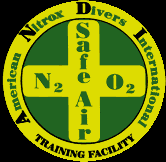
Wookey Hole Caves are a series of limestone caverns, a show cave and tourist attraction in the village of Wookey Hole on the southern edge of the Mendip Hills near Wells in Somerset, England. The River Axe flows through the cave. It is a Site of Special Scientific Interest (SSSI) for both biological and geological reasons. Wookey Hole cave is a "solutional cave", one that is formed by a process of weathering in which the natural acid in groundwater dissolves the rocks. Some water originates as rain that flows into streams on impervious rocks on the plateau before sinking at the limestone boundary into cave systems such as Swildon's Hole, Eastwater Cavern and St Cuthbert's Swallet; the rest is rain that percolates directly through the limestone. The temperature in the caves is a constant 11 °C (52 °F).

Technical diving is scuba diving that exceeds the agency-specified limits of recreational diving for non-professional purposes. Technical diving may expose the diver to hazards beyond those normally associated with recreational diving, and to a greater risk of serious injury or death. Risk may be reduced via appropriate skills, knowledge, and experience. Risk can also be managed by using suitable equipment and procedures. The skills may be developed through specialized training and experience. The equipment involves breathing gases other than air or standard nitrox mixtures, and multiple gas sources.

Cave-diving is underwater diving in water-filled caves. It may be done as an extreme sport, a way of exploring flooded caves for scientific investigation, or for the search for and recovery of divers or, as in the 2018 Thai cave rescue, other cave users. The equipment used varies depending on the circumstances, and ranges from breath hold to surface supplied, but almost all cave-diving is done using scuba equipment, often in specialised configurations with redundancies such as sidemount or backmounted twinset. Recreational cave-diving is generally considered to be a type of technical diving due to the lack of a free surface during large parts of the dive, and often involves planned decompression stops. A distinction is made by recreational diver training agencies between cave-diving and cavern-diving, where cavern diving is deemed to be diving in those parts of a cave where the exit to open water can be seen by natural light. An arbitrary distance limit to the open water surface may also be specified.

Swildon's Hole is an extensive cave in Priddy, Somerset. At 9,144 metres (30,000 ft) in length, it is the longest cave on the Mendip Hills. It has been found to be connected to Priddy Green Sink and forms part of the Priddy Caves Site of Special Scientific Interest (SSSI).

American Nitrox Divers International was founded by Ed Betts and Dick Rutkowski in 1988.
John Arthur Sheppard was a pioneer of cave diving in the United Kingdom and a founder, together with Graham Balcombe, of the Cave Diving Group.

Recreational caving in the United Kingdom dates back to the mid-19th century. The four major caving areas of the United Kingdom are North Yorkshire, South Wales, Derbyshire, and the Mendips. Minor areas include Devon, North Wales, and the Scottish Highlands.
Francis Graham Balcombe was a pioneer of cave diving in the United Kingdom and a founder of the Cave Diving Group together with Jack Sheppard.

Confédération Mondiale des Activités Subaquatiques (CMAS) is an international federation that represents underwater activities in underwater sport and underwater sciences, and oversees an international system of recreational snorkel and scuba diver training and recognition. It is also known by its English name, the World Underwater Federation, and its Spanish name, Confederación Mundial De Actividades Subacuáticas. Its foundation in Monaco during January 1959 makes it one of the world's oldest underwater diving organisations.
Martyn Farr is a leading exploratory cave diver and caver, known for his record-breaking cave dives and the exploration of many miles of previously undiscovered underground passages. As an author and photographer, he has written many books on the subject of cave diving history and techniques and caving locations.

The history of scuba diving is closely linked with the history of the equipment. By the turn of the twentieth century, two basic architectures for underwater breathing apparatus had been pioneered; open-circuit surface supplied equipment where the diver's exhaled gas is vented directly into the water, and closed-circuit breathing apparatus where the diver's carbon dioxide is filtered from the exhaled breathing gas, which is then recirculated, and more gas added to replenish the oxygen content. Closed circuit equipment was more easily adapted to scuba in the absence of reliable, portable, and economical high pressure gas storage vessels. By the mid-twentieth century, high pressure cylinders were available and two systems for scuba had emerged: open-circuit scuba where the diver's exhaled breath is vented directly into the water, and closed-circuit scuba where the carbon dioxide is removed from the diver's exhaled breath which has oxygen added and is recirculated. Oxygen rebreathers are severely depth limited due to oxygen toxicity risk, which increases with depth, and the available systems for mixed gas rebreathers were fairly bulky and designed for use with diving helmets. The first commercially practical scuba rebreather was designed and built by the diving engineer Henry Fleuss in 1878, while working for Siebe Gorman in London. His self contained breathing apparatus consisted of a rubber mask connected to a breathing bag, with an estimated 50–60% oxygen supplied from a copper tank and carbon dioxide scrubbed by passing it through a bundle of rope yarn soaked in a solution of caustic potash. During the 1930s and all through World War II, the British, Italians and Germans developed and extensively used oxygen rebreathers to equip the first frogmen. In the U.S. Major Christian J. Lambertsen invented a free-swimming oxygen rebreather. In 1952 he patented a modification of his apparatus, this time named SCUBA, an acronym for "self-contained underwater breathing apparatus," which became the generic English word for autonomous breathing equipment for diving, and later for the activity using the equipment. After World War II, military frogmen continued to use rebreathers since they do not make bubbles which would give away the presence of the divers. The high percentage of oxygen used by these early rebreather systems limited the depth at which they could be used due to the risk of convulsions caused by acute oxygen toxicity.

The following outline is provided as an overview of and topical guide to underwater diving:

The following index is provided as an overview of and topical guide to underwater diving: Links to articles and redirects to sections of articles which provide information on each topic are listed with a short description of the topic. When there is more than one article with information on a topic, the most relevant is usually listed, and it may be cross-linked to further information from the linked page or section.

John Paul Volanthen, is a British cave diver who undertakes cave rescues through the Cave Rescue Organisation, South and Mid Wales Cave Rescue, and the British Caving Association. In 2018, he played a leading role in the Tham Luang cave rescue. He cave-dives as a hobby and conducts rescues as a volunteer. He works as an IT consultant in Bristol.

Richard William Stanton, is a British civilian cave diver who specialises in rescues through the Cave Rescue Organisation and the British Cave Rescue Council. He has been called "one of the world's most accomplished cave-divers", "the face of British cave diving," and "the best cave diver in Europe". Stanton has lived in Coventry for many years, and was formerly a firefighter with the West Midlands Fire Service for 25 years prior to his retirement. In 2018 he played a leading role in the Tham Luang cave rescue and was awarded the George Medal in the Civilian Gallantry List.
The Underground Eiger is a made-for-television documentary that was released in 1979. It details a world record-breaking cave dive of 6,000 ft (1,800 m) made by Geoff Yeadon and Oliver Statham from West Kingsdale Master Cave, in North Yorkshire, England to Keld Head. An estimated 20 million viewers watched its television debut. It has been called "legendary in caving folklore," and notable cave diver Rick Stanton cites it as the impetus that sparked his interest in cave diving.

Cave diving is underwater diving in water-filled caves. The equipment used varies depending on the circumstances, and ranges from breath hold to surface supplied, but almost all cave diving is done using scuba equipment, often in specialised configurations with redundancies such as sidemount or backmounted twinset. Recreational cave diving is generally considered to be a type of technical diving due to the lack of a free surface during large parts of the dive, and often involves planned decompression stops. A distinction is made by recreational diver training agencies between cave diving and cavern diving, where cavern diving is deemed to be diving in those parts of a cave where the exit to open water can be seen by natural light. An arbitrary distance limit to the open water surface may also be specified. Despite the risks, water-filled caves attract scuba divers, cavers, and speleologists due to their often unexplored nature, and present divers with a technical diving challenge.

Penelope Powell was a pioneering cave diver. She was Diver No. 2 for the first successful cave dive using breathing equipment in Britain at Wookey Hole Caves in the Mendip Hills, Somerset on 18 August 1935. Powell was posthumously entered into the Women Divers Hall of Fame (WDHOF) in 2023.

The following index is provided as an overview of and topical guide to underwater diving:















